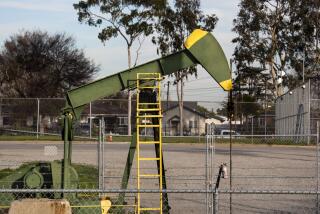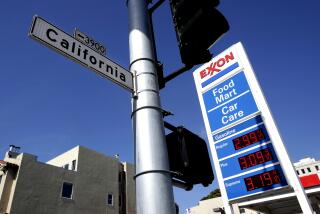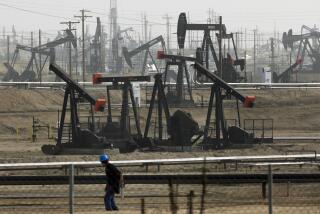BP’s dividend debate has investors watching
- Share via
The threat of a reduction in the dividend paid by energy giant BP is bringing up bad memories for investors who have suffered similar cuts by other once-reliable companies in the last decade.
Under pressure from the Obama administration to show it can foot the bill for the oil spill cleanup in the Gulf of Mexico, BP is contemplating slashing or even suspending the $10.5 billion a year it currently distributes to its shareholders. A decision could come Wednesday after company executives meet with the president.
The prospect of a disappearing dividend by BP could rattle investors who suffered big hits during the financial crisis when large banks and other companies chopped their payouts.
Shares that pay dividends have long been prized by retirees in need of regular cash income, and some experts are advising aging baby boomers and others to use dividend-paying stocks to anchor their nest eggs in the face of volatile stock prices and ultralow bond yields.
“Dividends are likely to become increasingly important,” said Alan Gayle, senior investment strategist at RidgeWorth Capital Management in Richmond, Va. “Given a decade of terrible equity performance, investors are in much more of a mind-set of ‘show me the money.’ ”
Historically, dividends have been a big component of a stock investor’s profits, accounting for 43% of the total return of the Standard & Poor’s 500 stock index since 1926, according to S&P.
The importance of dividends seemed to fade in the 1980s and ‘90s as stock prices rocketed. By the end of that era’s long bull market, the prevailing corporate philosophy called for companies to use excess cash to expand their businesses, make acquisitions or buy back stock, all of which had the potential to boost a firm’s stock price.
“Companies just are not as willing to put as much into their dividends as they used to,” said Phil Weiss, an analyst at Argus Research. “It is unfortunate for the baby boom generation and retirees that the dividend component for us is going to be less than it was for our parents and grandparents.”
Dividends paid by big U.S. companies grew in dollar terms through much of the last decade. But investors relying on the payouts were slammed in 2009. Last year saw the largest number of dividend cuts by U.S. firms — and the fewest increases — since at least 1955, as corporate managers sought to conserve cash during the recession.
Dividends paid by S&P 500 companies plunged to $196 billion last year from $248 billion in 2008. S&P projects they’ll rebound to $210 billion this year but won’t retake their peak until 2012.
The specter of a cash-conserving move by BP is a painful reminder of such actions by other onetime dividend stalwarts.
Electric utilities, for example, were a reliable source of dividend income until deregulation rocked that business in the 1990s. After the turn of the century, some major utilities hacked their payouts as they restructured to cope with growing competition.
Many cash-hungry investors then turned to financial companies such as Citigroup Inc. and Bank of America Corp., which offered relatively generous payouts as their earnings surged, thanks in part to the mortgage lending boom. But the housing crash, the financial crisis and the terms of bailout infusions from the government have devastated financial firms’ dividends.
In 2007, the financial sector accounted for 30% of dividends paid by S&P 500 index companies. That’s down to 8.8% now.
For all of 2009, 804 U.S. companies cut or eliminated their dividends, compared with only 110 reductions in 2007, S&P reported. The list of firms hacking payouts last year included such giants as General Electric Co., Macy’s Inc., Dow Chemical Co. and Pfizer Inc.
The number of companies initiating a dividend or raising payments plunged to 1,191 last year from 2,513 in 2007.
As corporate earnings have rebounded in the last few quarters, the dividend trend has improved sharply. The number of firms boosting or initiating dividends jumped to 399 in the first three months of this year from 283 in the first quarter of 2009.
Now, with interest yields on bonds at relatively low levels, some financial advisors have been touting stocks that pay cash dividends as the answer for investors who need income.
The current average annualized dividend yield of stocks in the S&P 500 index is about 2%. That’s just slightly below the 2.08% annualized yield of a five-year U.S. Treasury note. The yield is calculated by dividing an investment’s annual dividend or interest by the security’s price.
Some blue-chip companies, including Coca-Cola, Procter & Gamble and McDonald’s Corp., pay dividends yielding between 3% and 4% at current share prices.
What’s more, dividends offer one key advantage over bond interest: They can grow over time, while bond interest stays fixed. Also, for now at least, dividends are taxed at a much lower rate than interest payments are.
“I think there’s going to be a resetting of investor expectations,” said Josh Peters, an analyst at investment research firm Morningstar Inc. in Chicago who tracks dividend-paying stocks. With many equities showing no net rise in price over the last decade, he said, investors have come to realize that “you can’t count on capital gains when things get tough.”
Charles Carlson, a Hammond, Ind., money manager who writes a newsletter about dividend-paying stocks, said he believed that aging baby boomers who wanted to keep a portion of their money in equities would increasingly turn to shares of established firms that pay dividends.
The BP debacle notwithstanding, “I expect a fundamental change in people’s perceptions of the stocks that will do better — high quality, bigger companies,” he said.
Still, a crucial question is whether companies will opt to be more generous with dividend payments.
One obstacle to dividend increases this year is uncertainty about tax rates, Carlson said.
The maximum tax on dividend income was slashed in 2003 to 15% from 38.6%. But that special treatment for dividends will end next Jan. 1 unless Congress and the president act to preserve it. The Obama administration has signaled that it supports maintaining the 15% rate for couples earning less than $250,000 a year.
Another barrier to higher payouts, Carlson said, is that many companies need to feel more comfortable about the economic recovery before raising their dividends.
On the other hand, a rebound in corporate earnings in recent quarters has left U.S. companies holding a record $1.8 trillion in cash on their balance sheets, according to Federal Reserve data.
“It’s not as if they don’t have the money” to boost dividends, Carlson said.
More to Read
Inside the business of entertainment
The Wide Shot brings you news, analysis and insights on everything from streaming wars to production — and what it all means for the future.
You may occasionally receive promotional content from the Los Angeles Times.










